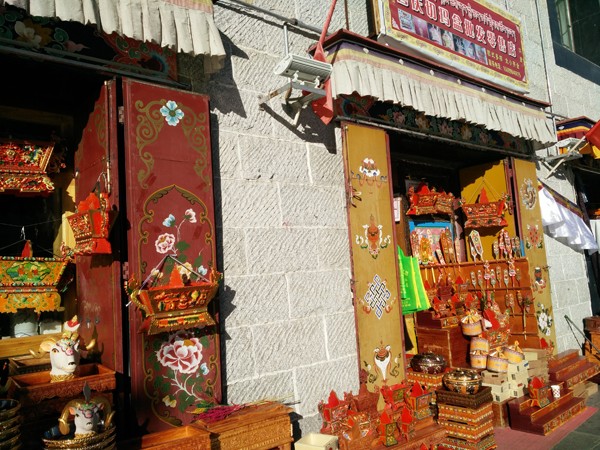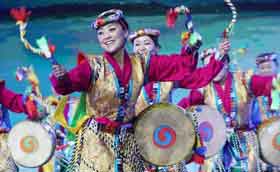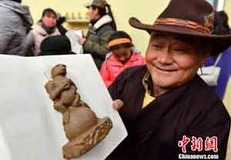Lhasa gets ready for Chinese New Year and Losar

Lhasa is filled with festive atmosphere to greet the coming Chinese New Year and Losar.[Photo/bjwmb.gov.cn]
Cultural activities with the theme of “One Chinese Family, Sharing the warmth of the Chinese New Year and Losar” kicked off in Lhasa on Jan. 10, Xinhua reported.
The streets of Lhasa are decked out with red flags, colorful banners and decorations. Many Lhasa residents come to the Barkhor Street to buy fresh flowers, fireworks, yak butter, and other special goods to celebrate the two coming festivals.
The Tibet Artists’ House has amassed an exhibition of more than 100 cultural objects relating to the Year of Monkey, including Thangka, printing blocks, Tibetan calligraphy, masks, clay sculptures, murals and others.
“There is an abundance of Monkey-related culture in Tibetan culture, from the origin of the Tibetan people, to Tibetan fables and people’s beliefs, as well as in Tibetan opera, dance, and traditional art,” said Ngawang, deputy director of the Tibet Autonomous Region Artists’ House. “The 2016 New Year’s Popular Culture” exhibition will present audiences with the Monkey- related cultural activities.
In traditional Tibetan culture, monkey means wisdom and the origin of the Tibetan people. It not only represents strong ethnic features but also the traditional Tibetan culture. The image of Monkey have repeatedly appeared on murals, in Tibetan opera and other intangible cultural art forms.
Starting from the 12th month of the Tibetan calendar, Tibetan families all begin to make preparations for the New Year. In both cities and rural areas, men, old and young will all have their hair cut, and women will plait new braids. Besides, each home will do a thorough cleaning to discard the old and bring in the new.
This year Losar falls on Feb. 9, one day after the Chinese New Year, or the Spring Festival. Losar is the biggest festival among all Tibetan festivals, and also the one with the strongest folk cultural features. During this period, areas around Tibet and other Tibetan-inhabited areas will hold local activities. The Tibetan people will also take ritual walks around Tibetan monasteries and pray, eat “gu thuk” soup two nights before Losar, hold horse races, and enjoy other New Year’s celebrations.
Your Comment
Name E-mailRelated News
-
;
-
-

-
First online New Year’s Gala features 2016 Tibetan grassroots sin
The first online Tibetan New Year’s Gala started on Jan. 12 with 2016 local performers invited to sing together, featuring fun.
-
-
-

-
Year of Monkey culture exhibition opens in Lhasa
The "2016 Year of the Monkey Culture Exhibition" opened in Lhasa on Jan. 10.
-
-
-

-
New Year concert staged in SW China
A New Year concert is staged in front of an ice waterfall at the altitude of 3,600 meters in Ganzi Tibetan Autonomous Prefecture, southwest China's Si
-
Based in Lhasa, Tibet Vista is a Tibet travel agency that specialized in Tibet permit, and Tibet tours for both private and group travelers at a local price!
•4 Days Lhasa City Group Tour from USD 460 •8 Days Everest Base Camp Group Tour from USD 850 •15 Days Mt.Kailash Group Tour from USD 1780 •2016 Tibet Train Tours from Beijing, Shanghai, Chengdu, Xining,etc










